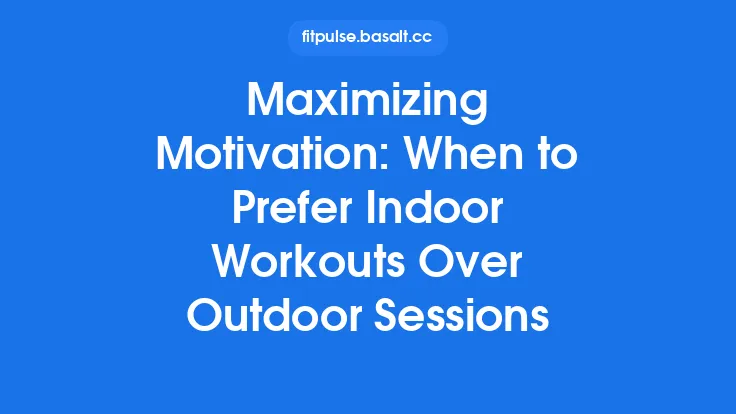Cardiovascular conditioning thrives on variety, and a hybrid cardio routine—one that fluidly alternates between indoor and outdoor sessions—offers a practical pathway to sustained progress. By weaving together the controlled environment of indoor training with the dynamic challenges of the outdoors, you can capitalize on the strengths of each setting while mitigating their individual limitations. This article outlines a systematic approach to designing, implementing, and fine‑tuning a hybrid cardio program that remains effective year after year, regardless of personal fitness level or equipment availability.
1. Defining the Core Objectives of a Hybrid Routine
Before you schedule any workout, clarify the primary outcomes you seek:
| Objective | How Indoor Workouts Contribute | How Outdoor Workouts Contribute |
|---|---|---|
| Aerobic Base Development | Precise control of speed, incline, and duration; easy heart‑rate zone targeting | Natural terrain variations that subtly challenge the cardiovascular system |
| Threshold & VO₂max Improvements | Structured interval protocols with exact work‑rest ratios | Real‑world pacing on varied surfaces that stress the cardiorespiratory system |
| Neuromuscular Adaptation | Consistent stride length and cadence on a treadmill or stationary bike | Unpredictable footing, wind resistance, and elevation changes |
| Recovery & Low‑Impact Sessions | Low‑impact elliptical or rowing for active recovery | Gentle jog or brisk walk on soft trails for active recovery |
By mapping each goal to the environment that best supports it, you create a logical framework for when to train indoors versus outdoors.
2. Periodization: Structuring Macro, Meso, and Micro Cycles
A hybrid routine benefits from periodization—the systematic variation of training variables over time. This prevents plateaus, reduces injury risk, and aligns training stress with recovery.
2.1 Macrocycle (Annual Plan)
- Phase 1 – Foundation (8–12 weeks): Emphasize aerobic base with 70 % indoor sessions (steady‑state treadmill runs, indoor cycling) and 30 % outdoor sessions (easy runs, bike rides).
- Phase 2 – Build (8–10 weeks): Shift to 50 % indoor, 50 % outdoor, introducing interval work outdoors (hill repeats) and threshold intervals indoors (tempo runs on treadmill).
- Phase 3 – Peak (4–6 weeks): Prioritize sport‑specific outdoor sessions (race‑pace runs, long rides) while maintaining indoor high‑intensity intervals for fine‑tuning.
- Phase 4 – Recovery (2–4 weeks): Reduce volume, favor low‑impact indoor modalities (elliptical, rowing) and gentle outdoor activity.
2.2 Mesocycle (4–6‑week Block)
Within each macro phase, design mesocycles that focus on a particular training quality (e.g., endurance, speed, power). Alternate indoor and outdoor emphasis every two weeks to keep stimulus fresh.
2.3 Microcycle (Weekly Layout)
A typical week might look like:
| Day | Session Type | Environment | Focus |
|---|---|---|---|
| Monday | 45‑min steady‑state run | Indoor (treadmill) | Aerobic base |
| Tuesday | 30‑min HIIT intervals | Indoor (stationary bike) | VO₂max |
| Wednesday | Rest or active recovery | — | — |
| Thursday | 60‑min tempo run | Outdoor (trail) | Lactate threshold |
| Friday | 40‑min cross‑training (row) | Indoor | Neuromuscular |
| Saturday | Long ride | Outdoor (road) | Endurance |
| Sunday | 30‑min easy jog | Outdoor (park) | Recovery |
Adjust the distribution based on personal schedule, travel, or facility access, but maintain the overall ratio dictated by the mesocycle.
3. Matching Intensity Metrics Across Environments
A common challenge in hybrid programming is ensuring that “hard” feels equally hard whether you’re on a treadmill or a forest path. Use objective metrics to bridge the gap.
3.1 Heart‑Rate Zones
- Determine Max HR using a validated field test (e.g., 5‑minute maximal effort) rather than age‑based formulas.
- Set Zones (Z1–Z5) and apply them consistently across indoor and outdoor sessions. Modern chest straps and optical sensors provide reliable data in both settings.
3.2 Power Output (Cycling)
- Indoor: Smart trainers deliver instantaneous wattage.
- Outdoor: Use a crank‑based power meter or a hub‑based system calibrated to the same standards.
- Calibration: Perform a “power curve” test on both devices to establish a conversion factor, allowing you to replicate indoor wattage targets outdoors.
3.3 Pace & Gradient Equivalence (Running)
- Treadmill Calibration: Set the treadmill incline to mimic the grade of your outdoor route. A 5 % incline roughly equals a 5 % uphill grade.
- Speed Conversion: Record your outdoor pace over a known distance, then input the same speed on the treadmill while maintaining the same incline. Adjust for wind resistance (outdoor) by adding ~5–10 % to treadmill speed for a comparable effort.
3.4 Perceived Exertion (RPE)
When physiological data are unavailable, the Borg RPE scale (6–20) offers a universal language. Train to recognize a “7” (moderate) or “15” (hard) regardless of setting, and log the corresponding heart‑rate or power for future reference.
4. Transition Strategies: From Indoor to Outdoor and Vice‑versa
Smooth transitions prevent performance drops and reduce injury risk.
4.1 Warm‑Up Adaptation
- Indoor → Outdoor: Extend the warm‑up by 5 minutes to accommodate the additional proprioceptive demands of uneven terrain. Include dynamic drills (leg swings, high knees) that mimic outdoor movement patterns.
- Outdoor → Indoor: Reduce warm‑up duration slightly (3–4 minutes) because the treadmill or bike provides a controlled surface; focus on gradually increasing cadence and incline.
4.2 Gear Synchronization
- Footwear: Use a versatile trainer that offers sufficient cushioning for treadmill work and enough ground feel for trail running. Rotate shoes every 300–500 km to maintain optimal support.
- Clothing: Opt for moisture‑wicking layers that can be added or removed quickly. A lightweight, breathable jacket works for both indoor climate‑controlled gyms and outdoor breezes.
4.3 Data Continuity
- Device Integration: Choose a platform (e.g., TrainingPeaks, Strava) that aggregates indoor and outdoor data into a single dashboard. This enables seamless tracking of weekly volume, intensity distribution, and progression.
- Session Tagging: Label each workout as “Indoor” or “Outdoor” within the app; this facilitates later analysis of performance trends across environments.
5. Programming Specific Hybrid Workouts
Below are three template workouts that illustrate how to blend indoor precision with outdoor variability.
5.1 “Hybrid Interval Ladder”
- Warm‑up: 10 min easy jog (indoor treadmill, Z1).
- Transition: 2 min dynamic stretch, step outside.
- Outdoor Ladder:
- 1 min hill sprint (≈Z5) → 1 min jog recovery (Z2)
- 2 min hill sprint → 2 min jog
- 3 min hill sprint → 3 min jog
- Reverse back down the ladder.
- Cool‑down: Return indoors, 8 min easy treadmill walk (Z1).
Rationale: Indoor warm‑up ensures heart‑rate elevation; outdoor hill work introduces natural resistance; indoor cool‑down provides a controlled environment for recovery.
5.2 “Indoor‑Outdoor Tempo Fusion”
- Day 1 (Indoor): 20‑min tempo run on treadmill at 85 % of lactate threshold HR, 2 % incline.
- Day 2 (Outdoor, 48 h later): 30‑min steady run on a flat park path at the same HR zone, focusing on maintaining consistent stride length.
Rationale: Repeating the same intensity in two environments reinforces physiological adaptations while teaching the body to interpret different external cues (incline vs flat surface).
5.3 “Cross‑Modal Endurance Block”
- Monday: 60‑min indoor rowing (steady Z2).
- Wednesday: 90‑min outdoor bike ride (steady Z2, varied terrain).
- Friday: 45‑min indoor elliptical (steady Z2).
Rationale: Alternating modalities reduces joint stress, while the mix of indoor and outdoor sessions maintains cardiovascular load without monotony.
6. Monitoring Progress and Adjusting the Hybrid Plan
A data‑driven approach ensures the routine evolves with your fitness.
6.1 Weekly Load Metrics
- Training Stress Score (TSS): Calculate TSS for each session (using heart‑rate or power). Sum weekly TSS to gauge overall load.
- Acute:Chronic Workload Ratio (ACWR): Keep the ratio between 0.8 and 1.3 to minimize overtraining risk.
6.2 Performance Benchmarks
- Monthly Time Trial: Choose a standard distance (e.g., 5 km run) and perform it both indoors and outdoors. Compare pace, HR, and perceived effort.
- VO₂max Re‑test: Every 8–12 weeks, conduct a submaximal treadmill or bike test to track aerobic capacity changes.
6.3 Adaptation Signals
- Positive Indicators: Stable or decreasing resting HR, improved HR recovery (e.g., 1‑minute HR drop post‑exercise).
- Negative Indicators: Persistent elevated HR at given intensity, increased RPE, or declining performance on benchmarks.
When negative signals appear, consider reducing overall volume, increasing recovery days, or temporarily shifting the indoor/outdoor ratio to favor lower‑impact sessions.
7. Nutrition and Hydration Strategies for Hybrid Training
Fueling requirements differ slightly between indoor and outdoor sessions due to environmental factors and sweat loss.
- Pre‑Workout: Consume 30–60 g of carbohydrates 60 minutes before a session lasting longer than 60 minutes, regardless of setting.
- During Outdoor Sessions: Carry 150–250 ml of fluid per 20 minutes of activity; use electrolyte‑enhanced drinks if sweat rate exceeds 1 L h⁻¹.
- During Indoor Sessions: Hydration can be more controlled; a water bottle within arm’s reach is sufficient for most workouts under 90 minutes.
- Post‑Workout Recovery: Aim for a 3:1 carbohydrate‑to‑protein ratio within 30 minutes of finishing, supporting glycogen replenishment and muscle repair.
8. Troubleshooting Common Hybrid Challenges
| Issue | Likely Cause | Practical Fix |
|---|---|---|
| Inconsistent perceived effort | Mismatch between indoor speed and outdoor terrain | Use a treadmill incline that mirrors outdoor grade; calibrate power meters regularly |
| Plateau in VO₂max despite varied sessions | Insufficient high‑intensity stimulus | Insert at least one weekly interval session (≥4 × 4 min at 90‑95 % HRmax) either indoor or outdoor |
| Joint soreness after alternating surfaces | Abrupt changes in impact forces | Incorporate a “transition” day with low‑impact indoor cardio (e.g., rowing) before high‑impact outdoor runs |
| Data gaps between devices | Different algorithms for HR or power | Export raw data to a spreadsheet and apply a uniform conversion factor; prioritize one device for longitudinal tracking |
9. Long‑Term Sustainability: Keeping the Hybrid Routine Fresh
- Seasonal Route Rotation: Even without focusing on weather, rotating between park loops, river trails, and urban circuits prevents monotony.
- Equipment Rotation: Alternate between treadmill, elliptical, and indoor bike to stimulate different muscle groups while preserving the indoor/outdoor balance.
- Goal Re‑assessment: Every 12 weeks, revisit your core objectives (e.g., shift from base building to race preparation) and adjust the indoor/outdoor ratio accordingly.
By embedding these habits, the hybrid cardio routine becomes a resilient component of your overall training architecture, capable of delivering consistent cardiovascular gains for years to come.





